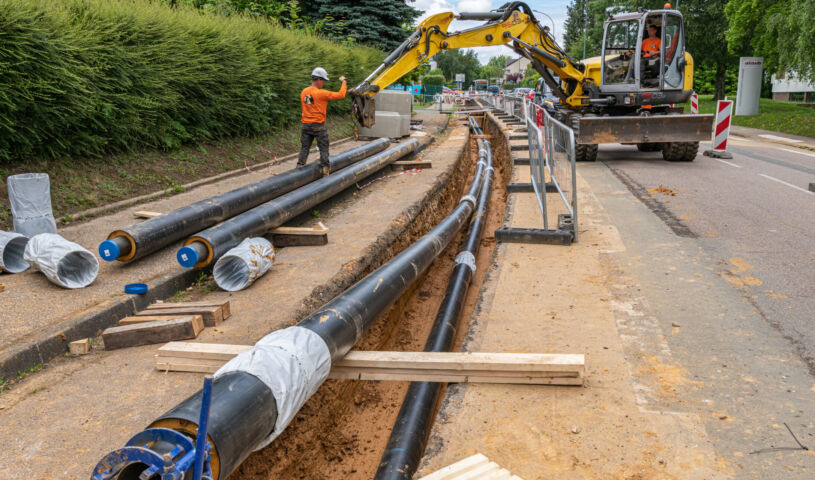It’s not just about housing. We need innovations in municipal finance
 Critical infrastructure isn’t cheap, whether financed by municipal debt, or funded through property taxes, utility rates, government grants, or levies on developers. So, who’s going to pay for all of that? Photo: Adobe Stock
Critical infrastructure isn’t cheap, whether financed by municipal debt, or funded through property taxes, utility rates, government grants, or levies on developers. So, who’s going to pay for all of that? Photo: Adobe Stock
Canada needs more housing, but to get there, we need the infrastructure – water lines, streets, sewers, storm drains and all the other essential municipal services – that make new homes possible. This critical infrastructure isn’t cheap, whether financed by municipal debt, or funded through property taxes, utility rates, government grants, or levies on developers.
So, who’s going to pay for all of that?
Given their tight financial positions, municipalities need to introduce new innovative approaches to take the pressure off the public purse by leveraging private capital, while preserving public ownership. Canada’s challenge to solve the housing crisis is also a challenge in how we finance infrastructure.
Billions in Investment Needed
Across the country, the estimated cost of housing-enabling infrastructure averages over $100,000 per newly developed home. Considering Canada’s housing targets, there are likely hundreds of billions of dollars required over time to fund the housing-enabling infrastructure needed across the country.
Municipalities are already struggling to keep up.
Municipalities are legally required to balance their budgets and cannot run operating deficits, so they are understandably fiscally cautious. They also often have both provincial and self-imposed debt ceilings that limit how much they can borrow to put toward new infrastructure projects. As a result, many municipalities often have a substantial portion of their infrastructure plans unfunded – projects “in waiting,” deferred until new sources of financing money are made available.
Compounding their challenge, municipalities also have limited financial tools at their disposal to pay for infrastructure required to support new growth.
Whether from property taxes, utility rates, capital grants or development levies, there is not enough money to pay for all the necessary infrastructure. Existing revenues can also be reduced by pressure to cut or waive fees to lower costs and accelerate the creation of new housing.
The situation is quickly becoming a lose-lose proposition for municipalities, developers, and prospective new homebuyers.
Financial Innovation Potential
The good news is that there are potential innovations in municipal finance.
One hopeful example is the Canada Infrastructure Bank’s “Infrastructure for Housing Initiative,” which provides flexible loans for critical infrastructure such as water, roads or transit.
It’s one possible path forward. To appropriately address the scale of the problem, we need many.
In our newly released report from the Canadian Urban Institute, “A Jump Start: Providing Infrastructure for More Housing,” we propose four fresh approaches to infrastructure investment. In combination, they would lower costs to homeowners, mitigate risks for municipalities, capture value from infrastructure investments to further public benefit and attract more public and private investment.
First, municipalities should move away from requiring pre-paid development charges, to an approach that provides secured long-term payments.
Most homeowners buy their home with a mortgage that spreads out costs. Taking a similar approach to financing our infrastructure could reduce housing costs in the near term and provide a more flexible infrastructure financing environment. This practice is already followed successfully in several provinces, such as Quebec.
Second, municipalities should develop new financing tools that allow them to share the real costs of infrastructure among all those who benefit from it, including developers.
Municipalities need more tools to derive revenue from the increased land value stemming from housing-enabling infrastructure, for reinvestment in needed amenities like better transit, parks, and community facilities. Developing a suite of tools and a policy environment that captures the value of public investment can help cities deliver more of the services needed to create truly complete communities.
Third, leverage private capital to invest in public infrastructure.
Financial risks should be shared with institutional investors that are in a better position to absorb them.
Reliable Funding is Key
Infrastructure projects that have a reliable revenue stream, like water or district energy, can equal half the cost of housing-enabling infrastructure. A combination of public and private debt could enable municipalities to finance and deliver more projects with their existing revenue sources while preserving public ownership of the infrastructure.
Finally, while most housing demand may be in metropolitan areas, provincial governments and their financing authorities should develop investment strategies that make it easier and less expensive for small, medium-sized, and rural municipalities to deliver infrastructure at the optimal scale.
Canada’s housing crisis is in large measure an investment crisis. We need more and better tools to invest in our growing communities, by creating the infrastructure that underpins them. Yes, it’s complicated, but there are solutions that will unlock housing by providing necessary infrastructure faster. MW
✯ Municipal World Executive and Essentials Plus Members: You might also be interested in Dr. Enid Slack’s article: Are Canadian cities fiscally sustainable?
Mary Rowe is CEO of the Canadian Urban Institute. Michael Fenn is a former Ontario Deputy Minister of Municipal Affairs and Housing.
Related resource materials:



